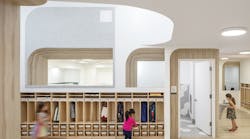"LED lighting demonstrates our innovative culture and commitment to the environment, while providing the practical benefits of energy savings and ultra-low maintenance," said Jeff Graybill, a partner with the agency.
Karlen Williams Graybill chose LED fixtures manufactured by Gallium Lighting, which has developed specification-grade LED downlighting – see Gallium Lighting introduces high output white LED downlight.
Each fitting consumes 25.5W. The CRI is 76-79 and the colour temperature is 4200K. Ling calculated that the light levels were about 840 lux (ignoring reflected light from the walls) in the middle of the counter shown in the kitchen photo.
"Many people are drawn to the obvious practical and aesthetic benefits LED lighting, but we have also been pleasantly surprised by the level of interest from people who specify LED lighting because it is the most environmentally-friendly lighting technology available," said Keith Bahde, president of Gallium Lighting.
"Unlike fluorescent lighting, LEDs contain no mercury, so there are no hazardous waste concerns. When people see the quality and quantity of light that the latest LEDs can produce, they realize that they don't have to compromise performance to go green."








